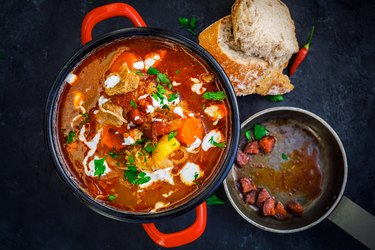
Feeling hungry even after a full meal? What you eat is essential to ensure a sated stomach because nutrients including protein, fiber and healthy fats add to the fullness factor. But how you eat these foods — specifically, the order in which you nosh — may be important, too.
Meal or food sequencing is the practice of eating greens or low-starch vegetables first, followed by protein-rich foods and/or fats and finishing off with complex carbohydrates. And it may be just the tiny tweak you need to help you feel full.
Video of the Day
Video of the Day
Here, experts share how food sequencing can support satiety and help your health in a host of other ways.
How Does Food Sequencing Help You Feel Fuller?
With food sequencing, there are a few factors at play that contribute to feeling fuller.
For one, the fiber found in veggies (the first food you're supposed to eat in the sequence) is "virtually non-digestible and can help slow the rate at which food is converted into sugar," says Lisa Moskovitz, RDN, founder and CEO of the NY Nutrition Group and author of The Core 3 Healthy Eating Plan.
Because fiber helps slow down the digestion of food, it gives you a steady stream of energy and helps keep cravings at bay.
In fact, people who ate a low-calorie bowl of high-fiber greens before pasta experienced increased fullness compared to those who skipped salad as a first course, according to a small February 2012 Appetite study of 46 people.
Secondly, protein and fat take longer to digest than carbohydrates, Moskovitz says. That means they exit your stomach slower, creating a greater sense of satiety and satisfaction. (That's why food sequencing has you eat protein and fat foods second, after fiber.) Indeed, starting your meals with foods high in water and fiber (such as veggies) followed by protein foods and then carb foods can help with satiety, per an October 2019 report in Nutrients.
"Proteins and fats also induce the secretion of satiety hormones from the GI tract to send signals to the brain," adds Stephany Ayoubi, RD, an associate dietitian at NY Nutrition Group.
Indeed, a September 2020 review in Nutrients noted that eating protein and/or fat before carbs stimulates the secretion of glucagon-like peptide-1 (GLP-1) from the gut. And GLP-1 not only slows gastric emptying but also suppresses appetite by affecting the hypothalamus.
Tip
It's also important to prioritize complex carbs in your meals instead of simple carbs. Unprocessed or minimally processed carby foods that are high in fiber are more slowly digested and increase satiety. Some examples include steel-cut oats, whole-grain barley, brown rice, bulgur, beans, peas and starchy vegetables (like corn and sweet potato).
3 More Potential Benefits of Food Sequencing
Not only does this dietary approach support a satisfied belly, but it also boasts other health benefits. Here are a few:
1. It Can Support Weight Loss and Weight Management
We now know that eating your food in a specific order (veggies first, protein-rich and fat-rich foods second and then carby foods third) can foster fullness. And the feeling of satiety promotes satisfaction and prevents overeating, which are important factors in fat loss and weight loss maintenance, Ayoubi says.
So if your goal is to lose weight, "starting off your meals with plenty of fibrous and voluminous veggies [like broccoli and cauliflower], followed by lean protein and fats, may offer the satisfaction and fulfillment you need to feel energized — and not deprived — even if you're eating less," Moskovitz says.
So prioritizing greens, lean protein and healthy fats first can help fill you up on fewer calories, Moskovitz says.
"This [method], in turn, may also help with portion control and creating more mindful eating experiences," which all support healthy weight loss, Ayoubi adds.
2. It's Linked to Blood Sugar Control
If you have concerns about your blood sugar, meal sequencing may be a terrific tool to help regulate your glucose levels, Moskovitz says.
Ayoubi agrees that eating in this way can promote more balanced blood sugar levels and prevent energy crashes or slumps.
And preliminary research backs them up: A small July 2015 study in Diabetes Care saw that food order had an effect on measures of blood sugar in adults with obesity and type 2 diabetes. The authors found a significant decrease in post-meal glucose and insulin levels when vegetables and protein were eaten before carbs in comparison to the reverse food order.
Here's why meal sequencing seems to stabilize blood sugar:
"Eating low-glycemic foods first, such as vegetables and proteins, allows the body to slowly convert these foods into sustainable energy," Ayoubi says.
That means preloading these foods can lead to long-lasting energy and help reduce rapid blood sugar spikes and dips, she says.
In contrast, "simple carbohydrate sources, such as bread, pasta or fruit, are generally metabolized much quicker and converted into sugars, also known as glucose, in the body," Ayoubi says. "This may result in a more rapid blood sugar spike after eating a meal," she explains.
Put another way, "carbs tend to have the most immediate and influential impact on blood sugar levels," Moskovitz says. But choosing the best options — whole-grain pasta, whole-grain bread, whole fruits and potatoes, for example — and keeping portions moderate will help temper sharp surges in blood sugar.
3. It Can Help Promote a Well-Balanced Diet
"Food sequencing can also help you eat a more balanced, nutritious diet," Moskovitz says.
"By strategically eating veggies and protein-rich foods first, you ensure that you're hitting your daily quota and ultimately getting in [many of] the essential nutrients for optimal health," she explains.
- Journal of the American Dietetic Association: “Salad and satiety: energy density and portion size of a first-course salad affect energy intake at lunch”
- Nutrients: “A Review of Recent Findings on Meal Sequence: An Attractive Dietary Approach to Prevention and Management of Type 2 Diabetes”
- Diabetes Care: “Food Order Has a Significant Impact on Postprandial Glucose and Insulin Levels”


